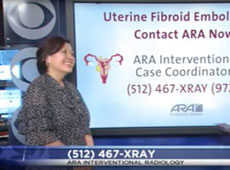Embolization for pelvic congestion (ovarian vein embolization) is an interventional radiology procedure used to treat painful pelvic varices. Pelvic varices are enlarged veins in the lower abdomen.
During embolization for pelvic congestion, the interventional radiologist inserts a catheter through a small nick in the femoral vein in the groin or internal jugular vein in the neck, then guides it through the vascular system to the ovarian vein. Using fluoroscopy, the catheter is guided to the area of enlarged veins. There, the catheter is used to deposit embolic agents such as coils, gelfoam, and/or sclerosant.
You can have pelvic varices and have no symptoms. When you do have symptoms of pelvic pain and heaviness (especially with prolonged standing) then there is concern that you may have pelvic congestion syndrome.
The diagnosis of pelvic congestion is made based on your symptoms and diagnostic studies which may include:
- Pelvic CT venography
- Magnetic resonance imaging (MRI) venography
- Pelvic and transvaginal ultrasound
Benefits
- Embolization for pelvic congestion is a minimally invasive radiology procedure for treating a condition that causes significant discomfort. It can be an alternative to hysterectomy.
- Some studies show a success rate of up to 85 percent using this technique.
- Interventional radiology techniques only require a small incision to reach structures deep inside the body. This reduces overall risk, complications, and recovery time.
- Embolization for pelvic congestion is often performed as an outpatient elective procedure.
Risks
- Embolization for pelvic congestion uses a very small dose of radiation, and the benefit from successful treatment far outweighs the risk. Please see ARA’s information on Radiation Safety.
- Women should always inform the scheduler, physician, and technologist if they are pregnant.
- In very rare cases, the catheterization may injure a vessel, which can cause bleeding or vessel blockage. This may require additional procedures to clear the vessel or stop the bleeding.
- In very rare cases (less than 1%), infection may develop after the procedure.
- Embolization for pelvic congestion is typically done in an outpatient interventional suite or as an outpatient hospital procedure. Procedure time is usually 1.5 to 2 hours, but can be longer depending on the complexity of the case.
- You may be asked to remove all metal and jewelry, and you will be asked to change into a gown.
- Before the exam, a paramedic or technologist will start an intravenous (IV) line in your arm or hand.
- You will be positioned comfortably on the exam table. At this point, a dose of sedative may be delivered through the IV to help you relax. The area where the catheter will be inserted may be shaved and will be cleaned and numbed with local anesthetic, which may sting briefly.
- The interventional radiologist will make a tiny nick in your skin and guide the catheter into the vein, then guide the catheter through the blood vessels until it reaches the area to be treated. At this point, contrast material is injected. You may feel a warm sensation as the contrast material enters your bloodstream during the imaging of blood vessels.
- Real-time imaging with fluoroscopy will guide the radiologist in directing the catheter and the treatment.
- Once the catheter reaches the area to be treated, embolic agents (coils, gelfoam, or sclerosant) will be released from the catheter tip to treat the pelvic varices and enlarged ovarian veins.
- More images may be taken to make sure the embolization was completed effectively.
- When the procedure is finished, the catheter is removed, and pressure is applied to the incision site.
- You may be asked to rest in bed for 2 to 3 hours after the procedure.
- You may engage in light activities for the first week following the exam. You can return to work the following day.
- Please let your health care provider and your scheduler know of all medications you are taking and if you have allergies, especially to iodinated contrast material. Also let them know about recent illnesses or ongoing medical conditions.
- If you take any blood-thinning medications, aspirin, or products containing aspirin, please contact our office for instructions on discontinuing the medications prior to your procedure.
- Women should always inform the scheduler, referring provider, and technologist if they are pregnant. It may be necessary to use an alternate procedure.
- Some health care providers recommend that breastfeeding women wait 24 to 48 hours until the contrast clears from their system before breastfeeding again.
- If your exam plans include giving you a sedative, you may be instructed not to eat or drink for 6 hours before the exam. You may take scheduled medication with small sips of water.
- You will be kept for observation at the facility until you are cleared to leave. Please arrange for a family member or friend to drive you home since you will receive moderate sedation.
Please call our interventional team at (512) 467-XRAY or (512) 467-9729 to schedule a physician consultation.
Follow-up appointments will be scheduled 1 month after the procedure and possibly again at 3 to 6 months.

 Back to Top
Back to Top